11 June 1778 Thursday
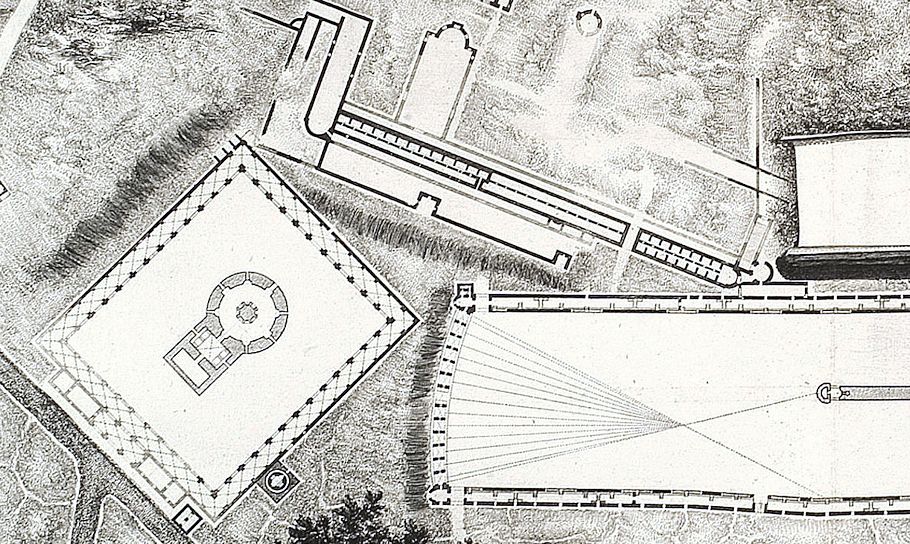
Mausoleum of Valerius Romulus, remains of ancient dining hall, Circus of Maxentius, plans, detail of Giovanni Battista Piranesi (attributed), 'Pianta degli avanzi di un 'antica Villa, sue Fabbriche, e Circo volgarmente detto di Caracalla fuori di porta S. Sebastiano' first state, circa 1775-78 in Le Antichità Romane vol. 1 (Universitätsbibliothek Heidelberg), 1787.
32 y.o. Francesco Piranesi 1 August 1790
Raccolta de'Tempj antichi, Vol. II.
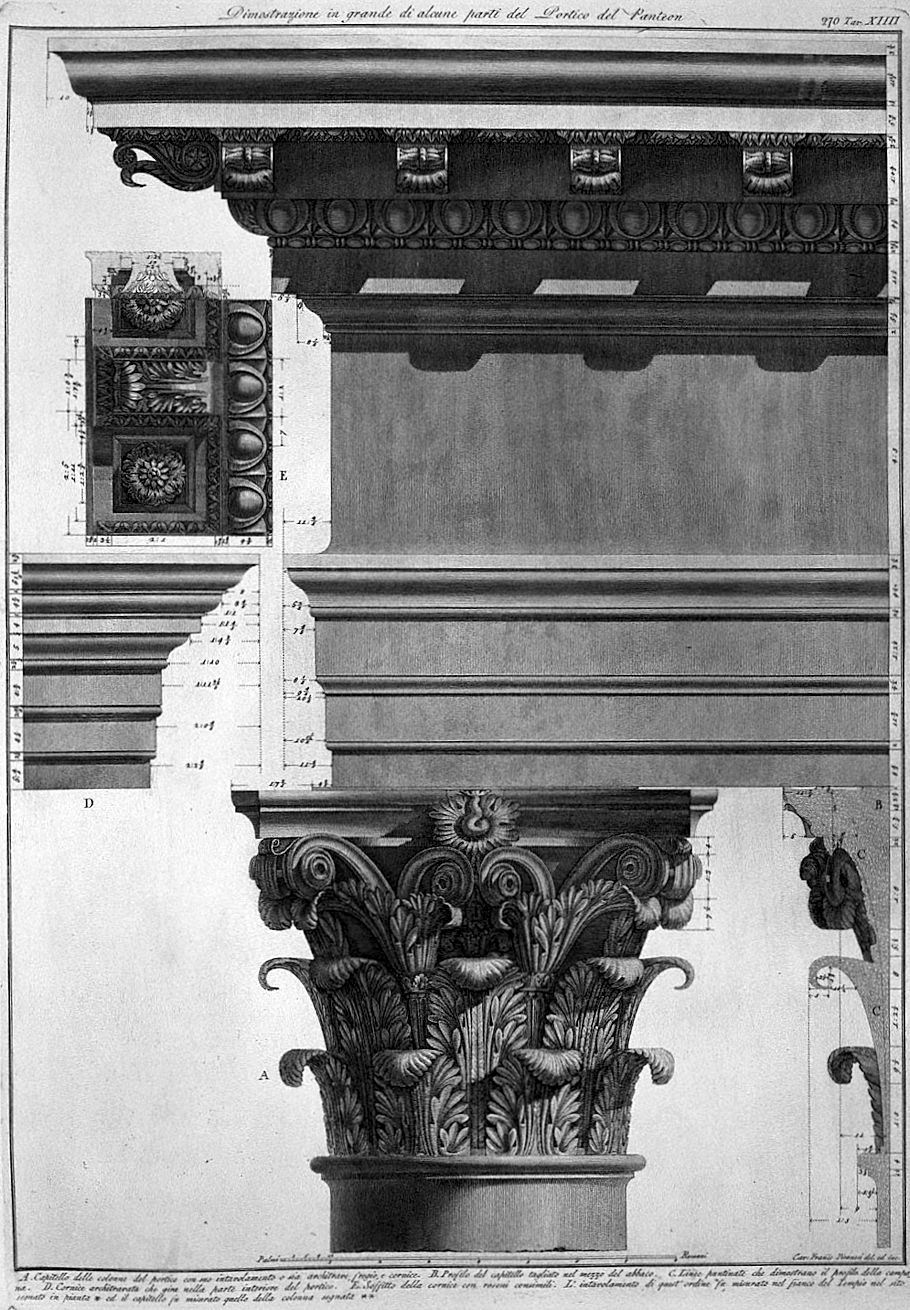
Large demonstration of some parts of the Portico of the Pantheon
A. Capital of the columns of the portico with its tablature or architrave, frieze, and cornice. B. Profile of the capital cut in the middle of the abacus. C. Dotted lines demonstrating the outline of the bell. D. Architrave frame that runs around the inside of the porch. E. Ceiling of the frame with similar rosettes.
The tabulation of this order was measured on the side of the Temple in the site marked on the plan * and the capital was measured that of the marked column **
Cav. Francesco Piranesi drawn and engraved
11 June 1812 Thursday
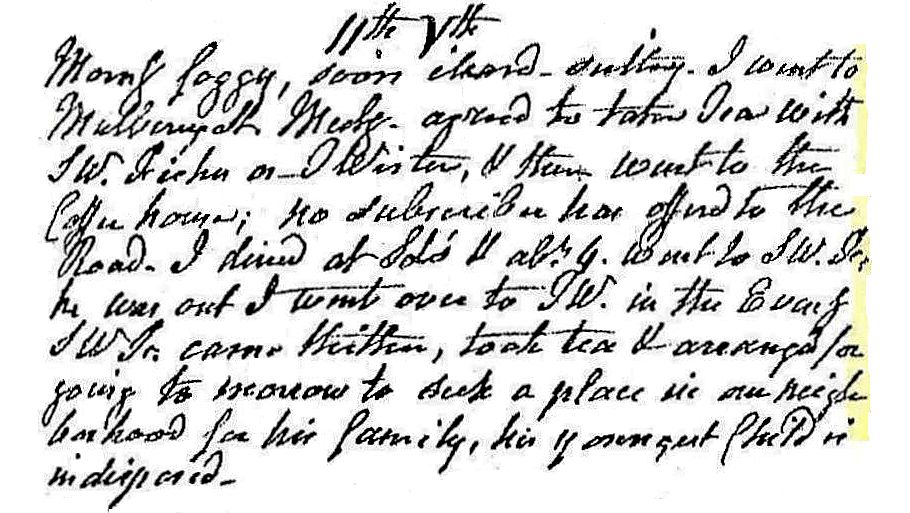
Morning foggy, soon cleared--sultry. I went to Mulberry St. Meeting. Agreed to take tea with S W Fisher or T Wister and then went to the Coffee House; no subscriber has offered to the road. I dined at SL's and about 4 went to SWF, he was out; I went over to TW. In the evening SWF came thither, took tea and arranged for going tomorrow to seek a place in our neighborhood for his family, his youngest child is indisposed.
11 June 1996
Einstein, History, and other Passions
From: Gerald Holton, Einstein, History, and other Passions, (Woodbury, AIP Press, 1995)
p.13-14: “Here we suddenly remember that, of course, the very same thing is true for scientists themselves. The most creative ones, almost by definition, do not build their constructs patiently by assembling blocks that have been precast by others and certified as sound. On the contrary, they too melt down the ready-made materials of science and recast them in a way that their contemporaries tend to think is outrageous. That is why Einstein’s own work took so long to be appreciated even by his best fellow physicists, as I noted earlier. His physics looked to them like alchemy, not because they did not understand it at all, but because, in one sense, they understood it all to well. From their thematic perspective, Einstein was anathema. Declaring, by simple postulation rather than by proof, Galilean relativity to be extended from mechanics to optics and all other branches of physics; dismissing the ether, the playground of most nineteenth-century physicists, in a preemptory half-sentence; depriving time intervals of inherent meaning; and other such outrages, all delivered in a casual, confident way in the first, short paper on relativity--those were violent and “illegitimate” distortions of science to almost every physicist. As for Einstein’s new ideas on the quantum physics of light emission, Max Planck felt so embarrassed by it when he had to write Einstein a letter of recommendation seven years later that he asked that this work be overlooked in judging the otherwise promising young man.”
This paragraph describes perfectly the metabolic imagination, and as I copied it here, I realized how I can now also use the creative thinking of Einstein as another example of the metabolic imagination in our time.
11 June 2002
Re: regarding your page w. Santa Croce
Grover,
I am not at all familiar with Medieval mysticism. What are the dates when mysticism was most prevalent? and where? I sometimes think I am in the midst of some sort of neo-mysticism whenever I pick up the Helena subject. Odd, coincidental things happen, and as more and more things happen I seriously have to wonder about 'signs'. I don't want you to think that I'm some sort of fanatic, rather I'm just an interested, educated person that's noticing odd things nonetheless. Is mysticism ever related to Pagan augury? I ask because the time of Helena and Constantine was a world where Paganism and Christianity were both in the same pot, so to speak.
Sessorium
It was within Piranesi's Ichnographia Campus Martius that I first encountered the word/name Sessorium. There are two identical building plans labeled Sessorium symmetrically positioned at either extreme of the Domus Alexandri Severi, which forms half of the complex surrounding the Ara Martis, the original Altar to Mars as erected by Romulus, adjacent to the Circus Agonalis Sive Alexandri, today's Piazza Navona, Rome.
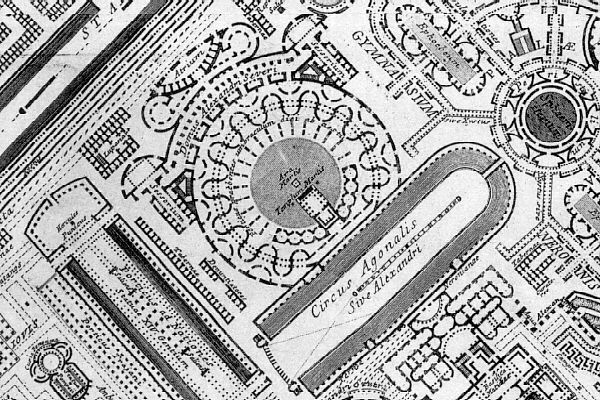
Detail of the Ichnographia Campus Martius with the Domus Alexandri Serveri toward the upper left center and the two Sessorium either side of the Domus Alexandri Severi.
The Latin definition of sessorium is first stool or chair, and, secondly, a place of residence, a dwelling, or habitation. It is, of course, the latter definitions that best fit the Sessorium as delineated within the Ichnographia Campus Martius, and there was, for the time being, no reason to think that there might be some further significance to the delineation and position of these plans within the larger, overall plan of the Campo Marzio.
In September 1998, I found out that there indeed once was a Sessorian Palace at Rome, but it was not located within the Campus Martius, nor was the Sessorian Palace a residence of the emperor Alexander Severus.
"Bassianus, came to Rome in 219 and, holding the family priesthood of the sun-god Elagabalus, declared that he and the god were one and the same, building himself a temple on the Palatine and laying out a new palace, later called the 'Sessorian', with its own circus and amphitheatre, on older imperial property in the south-east sector of the city."
Amanda Claridge, Rome: An Oxford Archeological Guide (Oxford: Oxford University Press, 1998), p. 21.
Elagabalus, a young teenage emperor reigning from 218-222 A.D., was succeeded by his cousin, Alexander Severus, who reigned 222-235 A.D. It is interesting to note that the description of the real Sessorian Palace somewhat matches the Domus Alexandri Severi as delineated by Piranesi, specifically how both palaces incorporate a circus/amphitheater.
Elagabalus was a homosexual, and, although he married several times, once even to a Vestal Virgin, he never produced an heir.
"The emperor also became involved in a series of homosexual crushes, most notably with the charioteer Hierocles. These favorites were given authority in the government, offending aristocrats, bureaucrats and troops alike. Elagabalus' personal style seemed effeminate and inappropriate to his office. Tales circulated that he spent his evenings pretending to be a female prostitute and that he wanted to have a vagina surgically implanted into his body."
www.roman-emperors.org/elagabal.htm
Could it be that Elagabalus located his new palace in Rome's south-east corner because it was close to the Castra Equitum Singuarlium, the barracks of the equites singulares, a select corps of cavalry organized about the end of the first century as a bodyguard for the emperor?
"The Sessorium, a building known in later times as the palatium Sessorianum, was standing in the first century, when it is mentioned as being near the spot where the execution of criminals took place. The origin of the name is unexplained, but the building became an imperial residence in the fourth century and was a favorite home of Helena, the mother Constantine. Its site is known, for the Church of S. Croce in Gerusalemme occupies one of the halls of the ancient palace."
Samuel Ball Platner, The Topography and Monuments of Ancient Rome (Boston: Allyn and Bacon, 1904), p. 448.
Given Elagabalus' reputation, it is perhaps understandable why Platner does not mention Elagabalus as the Sessorian Palace's builder and first imperial resident. Helena moved into the Sessorian Palace almost 100 years after Elagabalus' reign, and her reason for choosing the Sessorian Palace most likely coincides with Constantine's dissolution of the equites singulares, and his subsequently giving the land of the Castra Equitum Singularium and the adjacent Lateran Palace to the Papacy. Essentially, Helena moved in 'next door' to the Pope.
So, with all the background of the Sessorian Palace, why did Piranesi fuse the Domus Alexandri Serveri and the Sessorium and place them in a completely other part of Rome within the Ichnographia Campus Martius? On 21 September 1998 I asked myself, "Could Piranesi be weaving some complicated message which refers to both the reigns of Elagabalus and Alexander, where Alexander successfully undid the corruption of Elagabalus and began to turn Rome toward a more Christian and morally sound city and empire? The answer to that question requires a closer look at the Domus Alexandri Severi.
Alexander Severus
I just read about Alexander Severus in Encyclopedia Britannica because I have lately realized that two of the buildings in the Ichnographia Campus Martius--the Domus Alexandri Severi and the Porticus Alexandri Severi--have a close connection to Mars. The Domus Alexandri Severi is part of the compound enclosing the original altar of Mars, and the Porticus Alexandri Severi is the last building along the Equiria.
I wanted to see if there any particular reference to Mars relative to Alexander Severus, but no direct link was found, yet it is interesting to note that the emperor had considered dedicating a temple to Jesus, and that the military under his reign suffered significant losses. I am willing to propose that Piranesi uses Alexander Severus as signifying the beginning of the end [of Paganism within Rome]. If this is so, Piranesi is especially clever because he associates the beginning of the end directly with the Campo Marzio's true beginnings [viz. the Altar of Mars first erected by Romulus]. Furthermore, Alexander Severus is then also the beginning of the Pagan-Christian inversion [of Rome], and here I could point to the inversionary planimetric motifs evident in the porticus around the Altar of Mars, and similar inversionary motifs within the Porticus Alexandri Severi at the end of the Equiria.
Campo Marzio Note 0198 (1998.08.09).
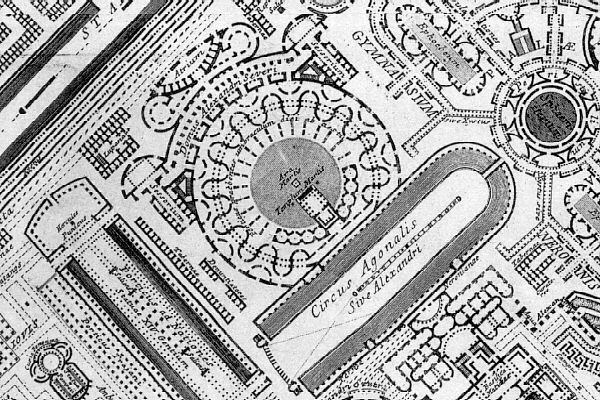
Detail of the Ichnographia Campus Martius with the Domus Alexandri Serveri toward the upper left center and the two Sessorium either side of the Domus Alexandri Severi.
"He used often to explain what he had heard from someone, either a Jew or a Christian, and always remembered, and he also had it announced by a herald whenever he was disciplining anyone, "What you do not wish that a man should do to you, do not do to him." And so highly did he value this sentiment that he had it written up in the Palace and in public buildings."
"Alexander Severus" in David Magie (translator), Scriptores Historiae Augustae (Cambridge, MA: Harvard University Press, 1980), vol. II., p. 283.
The Domus Alexandri Severi is not mentioned in the Historiae Augustae text, but my theory is that Piranesi placed the Domus Alexandri Severi along the Triumphal Way (in the reverse mode) because Alexander Severus favored Christianity and the Golden Rule. The Domus Alexandri Severi is also exactly like the description of Elagabalus' Palace near the Porta Maggiore. Could Piranesi be weaving some complicated message which refers to both the reigns of Elagabalus and Alexander, where Alexander successfully undid the corruption of Elagabalus and began to turn Rome toward a more Christian and morally sound city and empire?
Campo Marzio Note 0202 (1998.08.21).
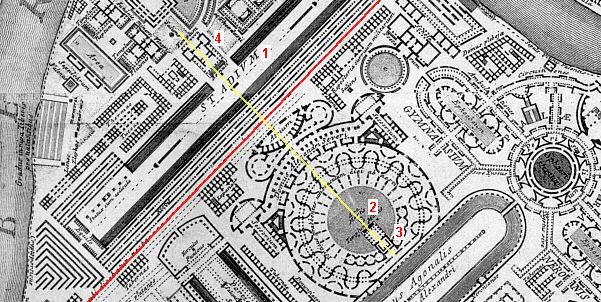
Once within the Campus Martius proper, the Triumphal Way moves along the length of an enormous stadium (1). No doubt, the intention here is for the Triumph to proceed through the stadium full of spectators. Furthermore, it is in conjunction with this Stadium that the Triumphal Way intersects a significant cross-axis. The Ara Martis (2), Rome's original altar to Mars, together with an adjacent Templum Martis (3) align with the Templum Romuli (4) that is part of the Stadium's composition. This is again a clear reference to the origins of Rome.
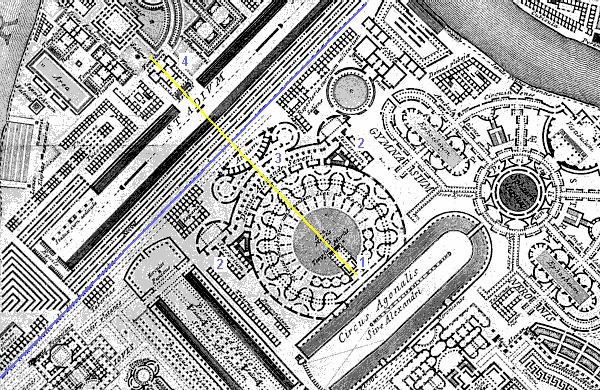
As the reverse Triumphal Way reaches the halfway point of the Stadium, it again crosses a significant axis, whose meaning too inverts from pagan to Christian. The axis, which spans from the Templum Martis (1) to the Templum Romuli (4), in its original sense symbolizes the very beginnings of Rome. When comparing this portion of the Ichnographia with Nolli's map of Rome, however, it becomes clear that Piranesi's position of the Templum Martis coincides exactly with the present day church of S. Agnese in Agone, the legendary site of the brothel to which St. Agnes was sent as a form of torture prior to her subsequent martyrdom. Agnes was supposed to lose her virginity in the brothel, a virginity she vowed to Christ. Agnes was not raped in the brothel, however, because of the protection of an angel; therefore Agnes was killed as a virgin. The execution of virgins was against Roman law and ethics, thus, the martyrdom of Agnes became a symbol of paganism's own corruption. In aligning the Templum Martis with S. Agnese in Agone, Piranesi makes an inverted link between Mars raping the Vestal Virgin Rhea, which brought forth Romulus and Remus and the founding of Rome itself, and the non-rape and virgin martyrdom of Agnes, which is one of the leading contributors towards the rise of Christianity in Rome.
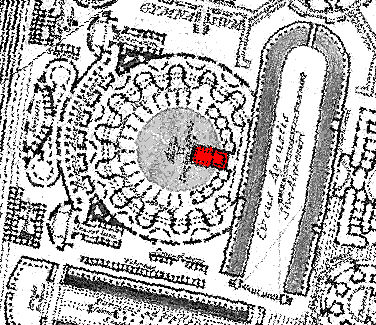 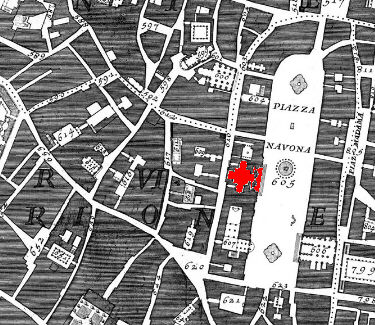
Piranesi reinforces the double meaning of the Templum Martis complex by including the Domus Alexandri Severi (3 above) and two Sessorium (2 above). Neither the Domus Alexandri Severi nor the Sessorium existed within this section of Rome, and Piranesi's placement of these buildings within the Campo Marzio is another example where the archaeological mistakes of the Ichnographia signify an "other" meaning. The emperor Alexander Severus is known for having been very interested and sympathetic towards Christianity, to the point where he seriously considered proclaiming Jesus as one of the official Roman gods, and he also carved the (inverting) words "do unto others as you would have them do unto you" over the door of his house. The Sessorium, on the other hand, is a direct reference to the Palatium Sessorianum, the imperial estate that became St. Helena's residence in Rome after 312, and subsequently the church of Santa Croce in Gerusalemme. St. Helena is the mother of Constantine the Great.
11 June 2004
life imitates art?
Last night, some inversionary reenactments were unexpectedly received from a friend.

Nice double theater.
If memory itself is humanity's primal manifestation of reenactment, and ritual is humanity's second manifestation of reenactment, is theater like number three?
"So what's double theater?"
"That's mostly baroque."
11 June 2020
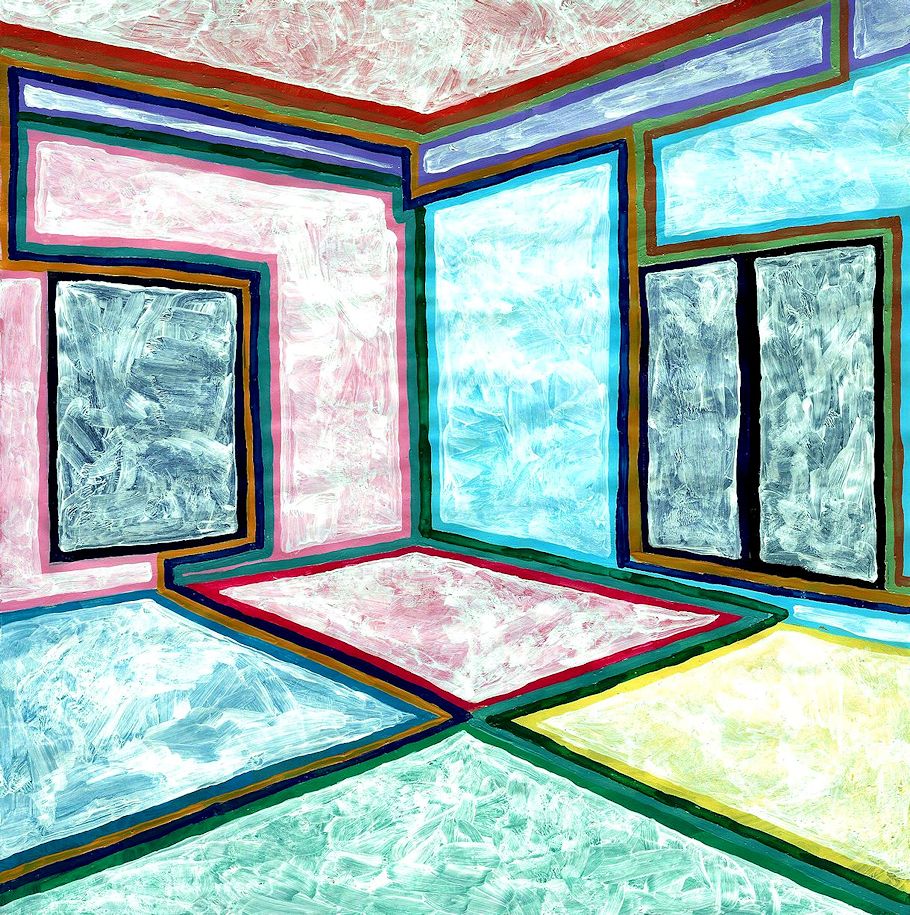
Mary Boone's 180 hours of community service hours 109 110 111
11 June 2023 Sunday
Early this afternoon, I found out that Giovanni Lodovico Bianconi wrote a book on the Circus of Caracalla. Bianconi died in 1781, and Descrizione dei circhi, particolarmente di quello di Caracalla e dei giochi in esso celebrati (Description of circuses, particularly that of Caracalla and the games celebrated in it) was published posthumously in 1789. In 1779, the year after Piranesi's death, Bianconi wrote/published a rather negative biography of Piranesi.
Here is what I've been able to focus on so far:

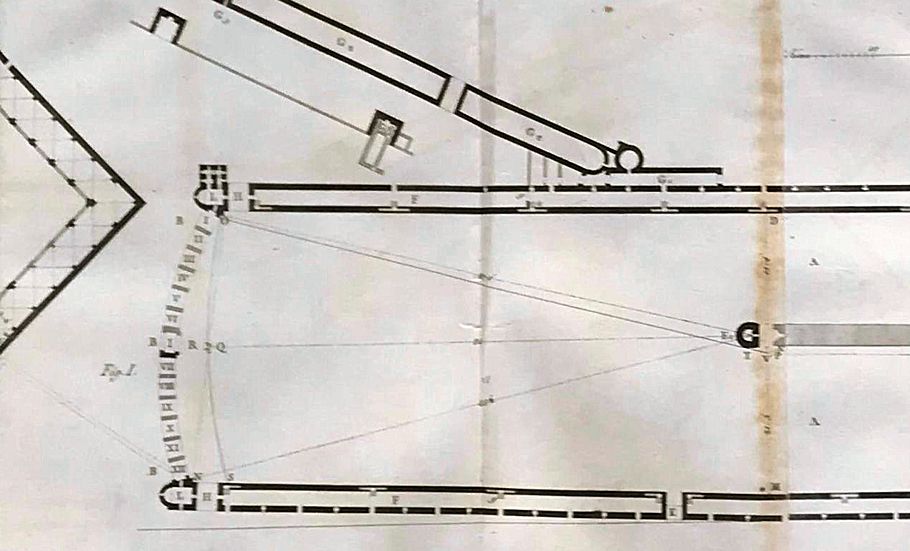
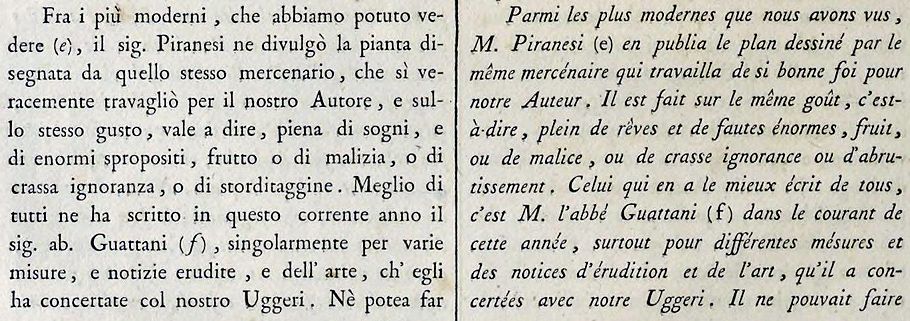
Among the most modern, which we have been able to see (e), Mr. Piranesi divulged the plan drawn by that same mercenary, who worked so sincerely for our Author, and in the same taste, that is to say, full of dreams, and of enormous blunders, fruit either of malice, or of crass ignorance, or of lightheadedness. Best of all, Mr. ab. Guattani (F), singularly for various measures, and erudite information, and of the art, which he has concerted with our Uggeri. [I still have to find out who this "same mercenary" is.]
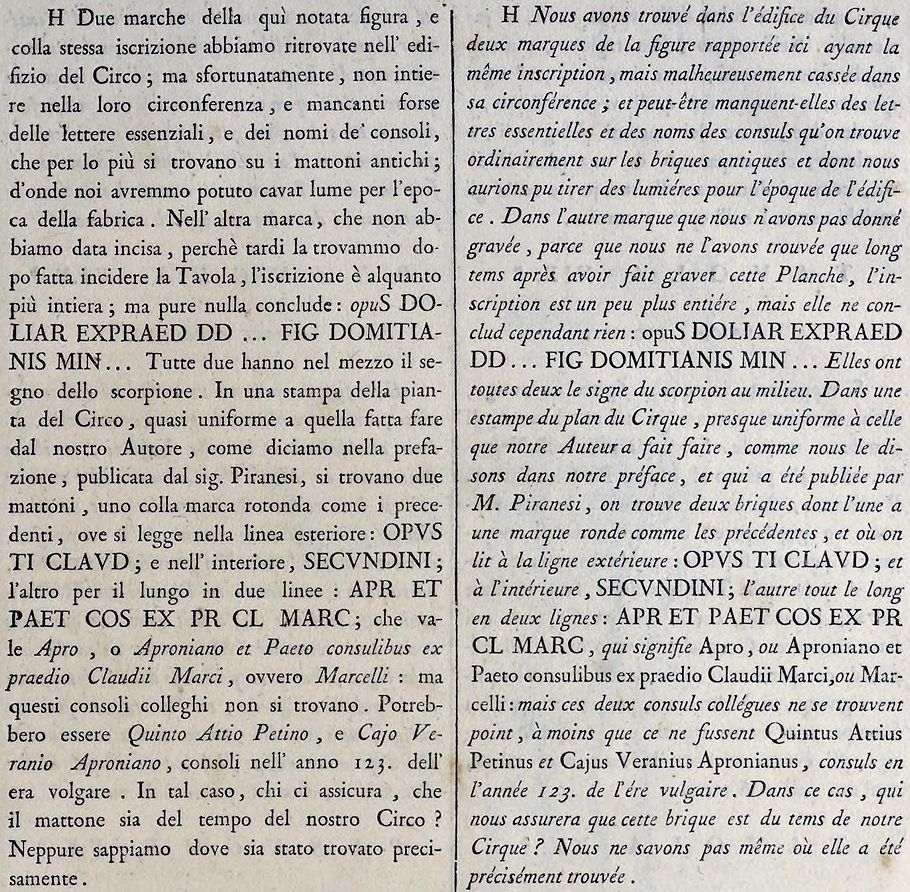
... In a print of the plan of the Circus, almost uniform to that made by our Author, as we say in the preface, published by Mr. Piranesi, there are two bricks, one with a round mark like the previous ones, where we read in the exterior line: ...
I did not expect Piranesi's final project to have had an actual antagonist. Just like when you're rapidly whipping, in preparing the wine/cream sauce for Coquilles St. Jacques, the plot suddenly thickens.
|